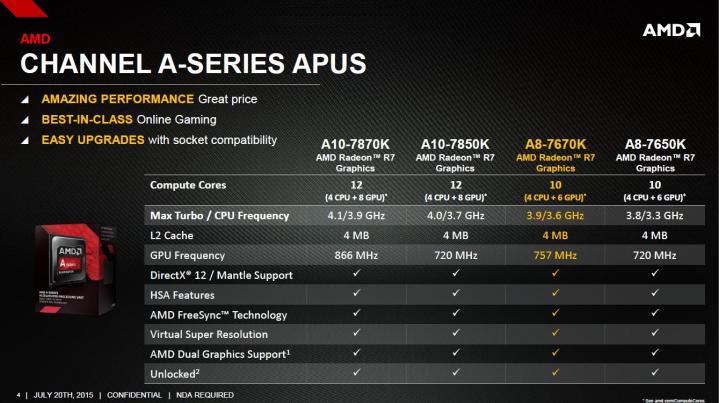
The new A8 processor is a quad-core, just like the A10, but it has a lower base clock of 3.6GHz and maximum Turbo Clock of 4.1GHz. That’s 300MHz slower on the base clock, and 200MHz behind in Turbo Boost. AMD has also cut back the chip’s Radeon graphics by two GPU cores, and reduced the GPU frequency from 866MHz to 757MHz. The upside of these changes is the price; the A8 is only $118, while the A10 retails at $140.
Though slightly slower than the company’s flagship APU, the new A8’s feature set is identical. It includes support for AMD FreeSync, Virtual Super Resolution, Dual Graphics, and is unlocked for easy overclocking of both the CPU and GPU cores.
AMD’s technical presentation highlighted the chip’s multi-core performance. Intel only offers dual-core chips at the same price point, and as a result the AMD chip has an edge in certain workloads and programs, such as Photoshop and 7-Zip. It also offers far superior graphics performance, up to doubling game performance in the best-case scenario (LEGO Batman 3 was given as an example). The chip can also deliver at least 30 frames per second in League of Legends, Heroes of the Storm, and Dota 2 at high or ultra detail and 1080p resolution.
Of course, not all the news is good. AMD typically doesn’t highlight tests that rely on per-clock performance for a very simple reason; it loses, badly. Any task that doesn’t rely on multiple cores is likely to show an advantage for Intel. The A8 is also behind the Core i3 in efficiency, as the former has a thermal design power of 95 watts, while the latter’s TDP is just 54 watts. In practical terms, a Core i3 system will use less energy, generate less heat, and get by with quieter cooling.
The A8-7670K should be available immediately at $117.99. It also fits right into the current FM2+ socket, so this could be a drop-in upgrade, though you should check your motherboard’s supported processor list before making a purchase. AMD pointed out that brand new compatible motherboards start as just $52, so a full system can be slapped together at a very low price.
Editors' Recommendations
- AMD Ryzen 9 7950X3D vs. Intel Core i9-13900K: only one choice for PC gamers
- AMD Ryzen 7000 could offer next-level overclocking ability
- AMD’s Ryzen 6000 processors could launch in 2022 with a key feature missing
- TCL’s 8K 6-Series mini-LED TVs are shockingly affordable
- AMD Ryzen 5900X vs. Intel Core i9 10900K: Revenge of the underdog?




